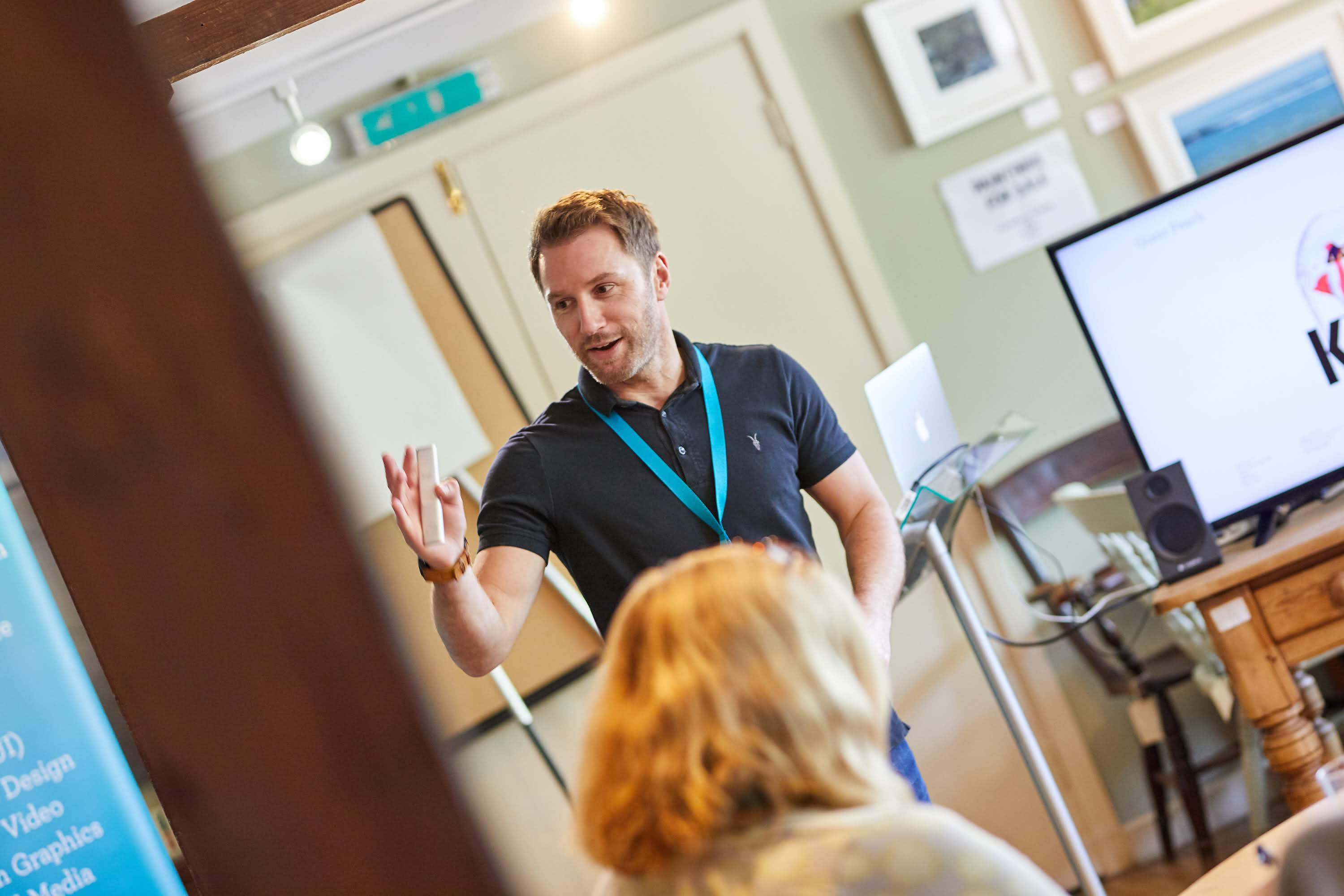High Growth Collective: Reinvention, content goals & breaking barriers!
For this month’s HGC event our expert speakers gave an insight on how to achieve a successful growing business by harnessing the power of Instagram, reinventing a brand and turning your sales strategy on its head.
From Revive to Doozy: A story of reinvention
Tim Varney, founder of Doozy

We’ve all got a view on vending machines. Views Tim Varney is all too aware of as he shared his advice on the highs and lows of rebranding and reinventing his vending business.
The backdrop
For the past 30 years, vending machines have been all about promoting big brands – Mars, Walkers, Pepsi and Coke. Products which are high in fat, sugar, salt and artificials. Most establishments like hospitals and universities wanted vending but with their poor rep, were embarrassed by the machines and products so tended to hide them away in corridors.
Back in 2013, sales were only going in one direction. Tim saw the writing was on the wall and needed to reinvent his business. The big questions he faced were:
- How to change the status quo and change people’s perception of vending?
- How to source and vend healthy products?
- How to get the vending machines into higher footfall areas?
- How would he compete with the big guys?
Tim’s answer to all this?
- Create a new brand
- Make vending look more appealing
- Source a whole new range of healthy products and set up a supply chain
- Convince hospitals and universities that vending doesn’t need to be the poor relation to canteens and cafes
- Create a platform to grow the business across the country
- Source funding for £500k
Moving on six years Tim did find the products, great eco-coffee and has reinvented the look of his vending machines which now have beautiful wooden covers. He’s successfully demonstrated to hospitals, colleges and universities that his vending machines would actually look very nice in high footfall areas.
Hard Lessons learned
By his own admission reinventing Revive was the hardest thing Tim has ever done and there were some hard lessons learned along the way…
1) Often the most obvious names for your brand are the worse ones to choose (Tim had a costly dalliance with the name ‘Honest’). Choose unusual or little used names which are easier to trade mark – such as Doozy!
2) Planning is important but some things you can’t plan for, especially when you are reinventing and trying something no one else has done before.
3) People you trust will let you down. Get over it, learn from it but don’t stop trusting.
4) Don’t be afraid to borrow money. Be afraid though of the wrong decisions you could make when that money hits your bank account!
5) Even when times are hard – keep going.
Tim’s successfully reinvented the vending business offering into something new and unique which is in keeping with a huge shift in consumer mindset and consumption habits. And we happen to think he’s done a top job of it!
Feast your eyes on Instagram – connect & build brand loyalty
James Read, founder of Giant Peach

It’s time for businesses to embrace the considerable power of Instagram. James shared his insights and it’s fair to say the Instagram numbers tell a compelling story…
- Instagram has over 1 billion active monthly users
- The platform has three times as many monthly users as Twitter
- Instagram engagement is higher than any other platform
- There are 24 million Instagram users in the UK alone
- It is the most popular platform across all age demographics
- In 2019, it is expected nearly 25% of Facebook’s total ad revenue will come from Instagram
Celebrate your brand story and personality
80% of all Instagram users follow a business account so James shared a few ways businesses can use Instagram to capture their audiences and generate leads:
- Tell your unique brand story. Be authentic and give an insider view of who you are and what you stand for using the Instagram grid and stories. The visual nature of Instagram means it tends to inspire and engage – something people are looking for and are more loyal as a result.
- Use Instagram to raise awareness of your products – use a mix of organic social media, sponsored ads and influencers. James’ tip is use micro influencers (those with between 2k and 50k followers) as they have an engaged audience and possibly more time to work with you.
- Start considering Instagram for business advertising – it’s cost effective and generates a lot of traction. Social shoppers are on the increase – 47% of people across Europe use social media as a buying platform and 28% will make a decision on a product based on the number of likes or comments it gets!
The Instagram Algorithm
There are two things the algorithm (how Instagram prioritises content for users) is looking for:
- Engagement – likes, comments, shares, video views, direct messages – especially within the first hour of the post.
- Relevancy – Instagram takes all user history, what you like, shared, watched commented on, didn’t commented on and serves up content which is it feels is most relevant.
Be warned! Instagram is tough! There is less than 10% chance of your post being seen by the audience – so the content needs to be relevant.
James’ top tips to great Instagram content
- Scroll-stopping imagery. You need to stop people in their tracks
- Use Instagram stories – they are an authentic way to give your audience an insider’s view
- Video is huge – it helps people stay on your platform for longer. Video doesn’t have to be cinematic – can be GIFs, Boomerangs or animations, the traction is unbelievable
- Use captions – be thought provoking, it helps get people to engage
- Competitions work – the simple mechanism of like and tag (a friend) is effective. As is partnering with brands which share similar audiences to you – double/triple the exposure!
- User generated content (content posted by your followers) – repost to increase genuine engagement with your audiences
- Use Instagram insights to get to know your audience better. See when they are online and engage with content and post accordingly
- #Hashtags – people are starting to follow more hashtags than accounts. Use them and be specific!
Now’s the time for businesses to get social! Give us a shout if you need any Peachy expertise or another pair of hands!
How to break sales barriers (warning: this might hurt!)
Benjamin Dennehy, UK’s Most Hated Sales Trainer

Widely known as the UK’s Most Hated Sales Trainer, Benjamin Dennehy kicked off by asking the HGC audience what was the one thing they would eliminate when dealing with sales prospects. Seems there is much to frustrate! When selling, people feel unliked or distrusted and experience difficulties managing expectations in the sales process.
The harsh truth from Benjamin is the reason most people fail at selling that prospects tend to bend the truth/mislead/lie and sometimes without even realising it – it’s not personal, we all do it! We say we’re interested when we’re not and say we’re not interested when we are. Apparently, it’s learnt behaviour from our childhoods.
But according to Benjamin, the bitter pill for sales people to swallow is this pattern is all their failing. We don’t all get out of bed saying: “I can’t wait to screw over a salesperson today!” To be fair – some people might, but really it’s the formulaic nature of sales which leads prospects to continue with their (however intentionally or unintentionally) deceiving responses.
What happens and why
1) Most sales people qualify their prospects poorly. Buying decisions are based on money, authority and need. “Are you the decision maker? Do you have a budget? Is this something you need?”
2) Sales people love talking about their expertise and knowledge which encourages quick fire questions from the prospect. We’re all programmed to give an answer if we are asked a question, so panic to respond.
3) It’s difficult to close a deal in a system where all the prospects and sales people’s behaviours complement each other. Picture the scene:
Sales person: “Let me find out if you’re the decision maker.”
Prospect: “You can try but I’ll probably just fob you off.”
Sales person: “Let me tell all about myself and just how much I know on the subject.”
Prospect: “Oh good. I was planning on grilling you and taking advantage of your expertise.”
Sales person: “So do we have a deal?”
Prospect: “Mmm not sure, I haven’t got any real reasons to commit.”
This system serves prospects very well! It turns salespeople, experts in their fields, into free consultants. And to make this whole process stick in the throat, alongside that earlier bitter pill, is when sales people are asked to ‘document their stupidity’ by sending over a proposal – a document full of ideas and of substantial value!
It’s at this point that Benjamin says salespeople turn into the type of salespeople they all say they’re not – pushy. They pick up the phone and chase, they send emails to chase and desperation for the ££ allows it to happen.
How people actually buy
We all buy emotionally and then justify intellectually, yet the sales process is designed to make it a purely intellectual experience. Sales people need to bring in the emotion and make it more human and not leave all the power with the prospect. If you think of all other interactions, they are not one sided like this and that’s because the sales process makes it all about the money. Bring back the balance, create a human connection and don’t give away your expertise for free!
If you’d like to speak at or come along to a future High Growth Collective, get yourself on our email list and get inspired.